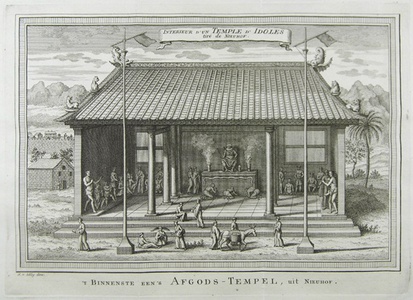| Method | Copper engraving |
| Artist | Jakob van der Schley |
| Published | [A la Haye, Chez Pierre de Hondt, MDCCXLIX. Avec Privilege de Sa Majeste Imperiale, & de Nos Seigneurs les Etats de Hollande & de West-Frise. 1749] |
| Dimensions | Image 174 x 259 mm, Plate 198 x 273 mm, Sheet 264 x 394 mm |
| Notes |
An illustration of a Chinese Temple from the Dutch edition of the Description de la Chine, part of Prévost's monumental 'l'Histoire Géneral des Voyages.' The plate depicts a large portico, closed on three sides, but with an open facade. Inside, a large altar is surmounted by a seated idol, beside which burn two braziers of incense. The portico is populated with worshippers, holy-men, and further idols. The tiled roof of the temple is ornamented with dragon-grotesques, and a pair of flagpoles stand in the courtyard in front of the temple. The depiction is attributed to the description of Nieuhof, but makes no mention to whom or what the temple shrine is dedicated. Perhaps it is representative of ancestor-worship, a facet of Chinese culture that particularly fascinated western audiences at the time. The Histoire Géneral des Voyages was a monumental eighteenth century general history divided according to geographic region. The original volumes were written by Antoine François Prévost d'Exiles, a French author, novelist, theologian, natural historian, and a priest of the Jesuit and Benedictine orders, but continued by numerous other authors after Prévost's death. The earliest books mostly deal with the Far East and South-East Asia, providing a general history of their regions, kingdoms, customs, culture, costumes, natural phenomena and religious beliefs. Much of Prévost's information is derived from the reports of Jesuit missionaries, Portuguese merchants, and famous explorers, from Marco Polo to Sir Francis Drake. Although written in French, the popularity of the Histoire among Dutch audiences meant that many of the illustrative plates and maps published to accompany the work were either re-engraved or subtitled in Dutch by the engraver Jakob van der Schley. Prévost himself had travelled widely throughout the Netherlands, launching his literary career in Amsterdam and the Hague after fleeing the Benedictines in France. Prevost's work on China, and indeed many of van der Schley's plates, owe a great debt to Johan Nieuhoff (1618-1672) , a Dutch traveller who explored much of China, India, and Brazil while in the employ of the Dutch East India Company. Nieuhoff wrote extensively, with a particular focus on China, for his memoirs, and his numerous drawings of Chinese places and people were much copied by later engravers for numerous works of Chinese interest. Nieuhoff's own book became a major source of inspiration for eighteenth century chinoiserie, and are amongst the first western illustrations to depict the Chinese people in a manner which was based upon personal observation rather than the tradition of oriental fantasy. Jakob van der Schley (26th July 1715 - 12th February 1779), also known as Jan von Schley or Jacobus van Schley, was a Dutch engraver and draughtsman. An apprentice of the French engraver Bernard Picart, he is best known for his engravings of the majority of plates in the Dutch edition of 'l'Histoire Géneral des Voyages.' Despite producing mainly maps and views for this work, van der Schley was predominantly a portrait artist and literary illustrator. Condition: Vertical folds as issued. Binders crease and holes to right margin. Clean, crisp impression. |
| Framing | unmounted |
| Price | £60.00 |
| Stock ID | 40792 |

